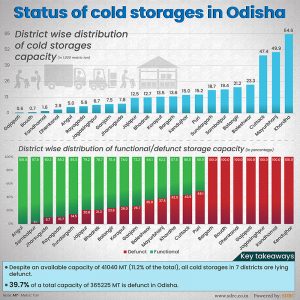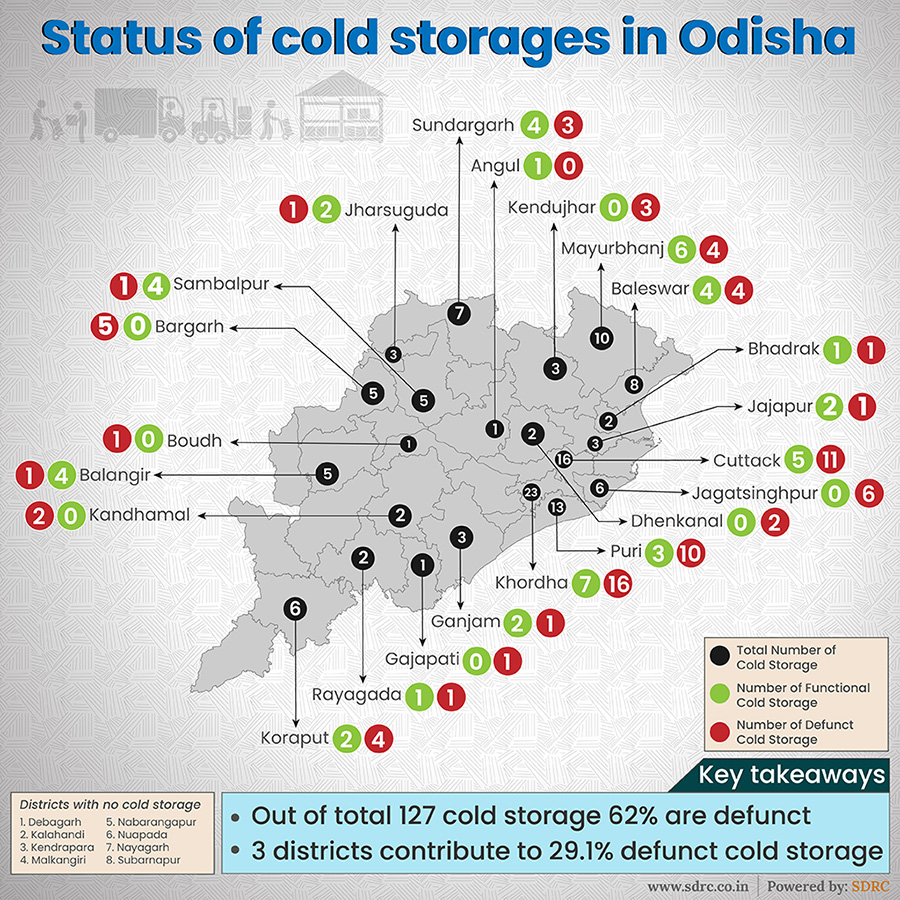Did you know that more than 1.45 lakh tonnes of fruits and 4-5 lakh tonnes of vegetables go waste in Odisha every year?
Cold storages play a key role in increasing the production of fruits and vegetables. They extend shelf life of produce, maintain quality, prevent oversupply, reduce transport bottlenecks, and period of marketing during the peak period.
Odisha, being a producer of a wide array of fruits and vegetables round the year, witnesses a lot of them go waste.
As per a survey on post-harvest losses by Indian Council of Agricultural Research (ICAR) in 2015, Odisha sees over 1.45 lakh tonnes fruits and more than 4-5 lakh tonnes of vegetables perish every year!
Does that mean that we don’t have enough cold storages?
As per Assembly Answers 2018, there are 127 cold storages in 30 districts, out of which 79 are defunct. Although each district average about 4 cold storages, the distribution is quite uneven.
Three districts have the highest concentration of cold storages. Khorda has 23 facilities (the highest in the state) of which 16 are defunct. Cuttack has 11 of its 16 units obsolete, while 10 out of 13 in Puri aren’t not working. These three districts account for 29.1% defunct cold storages.
As many as eight districts – Debagarh, Kalahandi, Kendrapara, Malkanigiri, Nabarangapur, Nuapada, Nayagarh, and Subarnapur – don’t have any.
Seven districts – Gajapati, Dhenkanal, Jagatsinghpur, Kendujhar, Bargarh, Boudh, and Kandhamal – have 20 cold storages in total, with an available capacity of 41040 MT. All of them are lying defunct. As much as 39.7% of total capacity of 365225 MT is defunct in the state.
What can be done to improve the situation?
- Most of the districts with no cold storage are among the leading producers of perishable commodities. Production capacity in each of them needs to be assessed and adequate numbers of storage facilities must be built.
- The defunct facilities must be restored and used to their optimal capacities.
- Some districts like Angul, Rayagada, Bhadrak, Ganjam, Jharsuguda and Jajpur have abysmally low facilities. Steps need to be taken to increase those.
- Cold storages should be customized to store the specific horticultural crops each district produces. While Kandhamal is a major turmeric producer, Kendujhar is a key tomato producer. So, they should have the facilities to store their respective harvest.
- Private players should be encouraged to build facilities and incentivized to carry on their operations during tough times.

Download Snapshot-1, Snapshot-2





Nice Article.
Would be good to understand the following points:
1) Why are these cold storages getting defunct in the first place.
2) How can we develop a strong value proposition and sustainable business model around cold storage operations so that private sector investments could be brought into the sector.
3) And what technology innovations are currently in place across India and the world that can be adapted to the context of Odisha.
A very sad state of affair. We are unable to use the existing resources which could help save thousands of tonnes of food produce from being wasted. As rightly pointed out have witnessed tonnes and tonnes of tomatoes lying wasted on fields, roads, etc in Keonjhar a couple of years back. Not even the cattles touched it. The price of tomato slashed to Rs. 1-2/kg in most markets during that period. It’s high time these facilities are utilised and leveraged to save the produce from getting damaged and the farmers get their worth for their efforts.
Useful article filled with lots of information.
How to overcome from this issues. Govt. should give more important and facilitate for more number of Cold storage to be made. I m also interested to make it. Please help.
Informative article.
Dear All,
Myself from a pvt. company called Kingspan Jindal in the field of cold storage panels. We shall be happy to assist you for your new/expansion in cold store projects.
Pl. contact us for the same on 9971150350.
with regards
Deepak Khurana
kh*********@***il.com